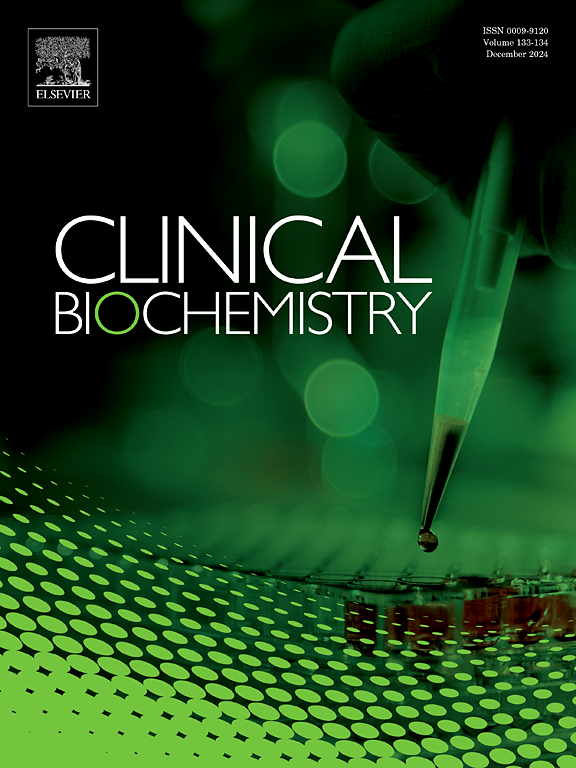How effective is serum FGL1 measurement in assessing disease activity: A cross-sectional study in rheumatoid arthritis
IF 2.1
3区 医学
Q2 MEDICAL LABORATORY TECHNOLOGY
引用次数: 0
Abstract
Introduction
In rheumatoid arthritis, which is an autoimmune inflammatory disease with multisystemic involvement, especially the joints, tracking disease activity is quite valuable in order to improve the quality of life of patients and to develop individualized treatment strategies. In this study, we evaluated the role of Fibrinogen-Like Protein 1 (FGL1), which has recently been shown to be associated with various rheumatological and autoimmune diseases, in disease diagnosis and activity in rheumatoid arthritis (RA).
Material and Methods
In this prospective study consisting of 108 RA patients divided into two groups as low disease activity-remission group (LDA) and moderate-high disease activity group (MHA) according to the Disease Activity Score 28-C-reactive protein score and 56 controls, serum FGL1 level was measured by Enzyme Linked ImmunoSorbent Assay (ELISA).
Results
Serum FGL1 level was found to be statistically significantly higher in RA patients compared to the control group, and in the MHA group compared to the LDA group. The mean FGL1 level was determined as 805.37 ng/ml in the LDA group, 1055.5 ng/ml in the MHA group and 652.31 ng/ml in the control group (p < 0.001). There was a positive correlation between FGL1 level and CRP, Erythrocyte Sedimentation Rate (ESR), CRP/Albumin levels.
Conclusions
Increased serum FGL1 levels were found to increase the likelihood of identifying patients with moderate-to-high disease activity RA. FGL1 is also effective in evaluating disease activity when used together with other inflammation markers, especially CRP/Albumin.

血清FGL1测量在评估疾病活动性方面有多有效:类风湿关节炎的横断面研究
类风湿关节炎是一种多系统累及的自身免疫性炎症性疾病,尤其是关节,跟踪疾病活动对于提高患者的生活质量和制定个性化的治疗策略是非常有价值的。在这项研究中,我们评估了纤维蛋白原样蛋白1 (FGL1)在疾病诊断和类风湿关节炎(RA)活动中的作用,FGL1最近被证明与各种风湿病和自身免疫性疾病相关。材料与方法本前瞻性研究将108例RA患者根据疾病活动性评分28- c反应蛋白评分分为低疾病活动性缓解组(LDA)和中高疾病活动性组(MHA),对照组56例,采用酶联免疫吸附试验(ELISA)检测血清FGL1水平。结果RA患者血清FGL1水平明显高于对照组,MHA组明显高于LDA组。LDA组FGL1平均水平为805.37 ng/ml, MHA组为1055.5 ng/ml,对照组为652.31 ng/ml (p < 0.001)。FGL1水平与CRP、红细胞沉降率(ESR)、CRP/白蛋白水平呈正相关。结论血清FGL1水平升高可增加识别中高疾病活动性RA患者的可能性。当FGL1与其他炎症标志物(尤其是CRP/白蛋白)联合使用时,也可有效评估疾病活动性。
本文章由计算机程序翻译,如有差异,请以英文原文为准。
求助全文
约1分钟内获得全文
求助全文
来源期刊

Clinical biochemistry
医学-医学实验技术
CiteScore
5.10
自引率
0.00%
发文量
151
审稿时长
25 days
期刊介绍:
Clinical Biochemistry publishes articles relating to clinical chemistry, molecular biology and genetics, therapeutic drug monitoring and toxicology, laboratory immunology and laboratory medicine in general, with the focus on analytical and clinical investigation of laboratory tests in humans used for diagnosis, prognosis, treatment and therapy, and monitoring of disease.
 求助内容:
求助内容: 应助结果提醒方式:
应助结果提醒方式:


